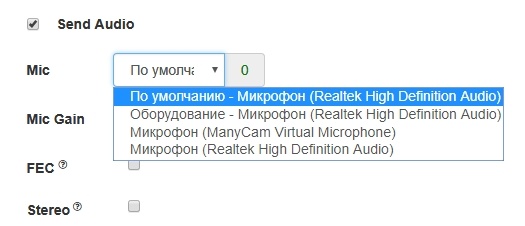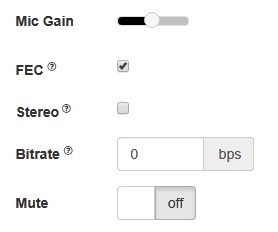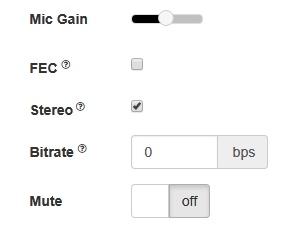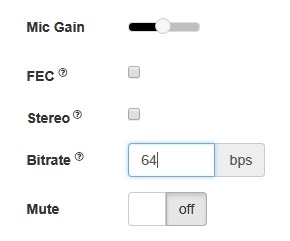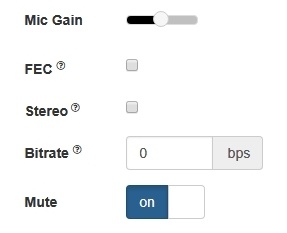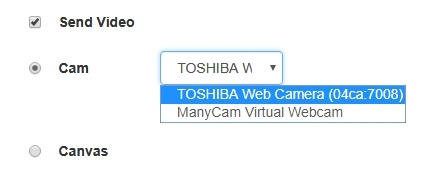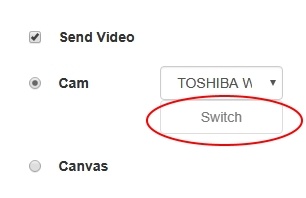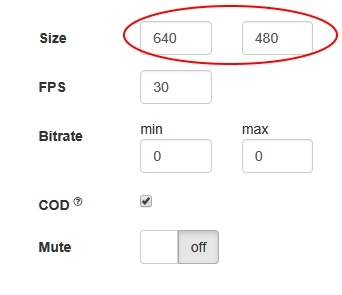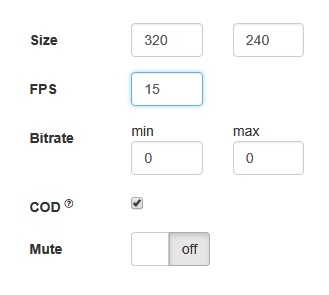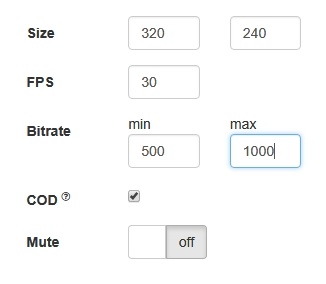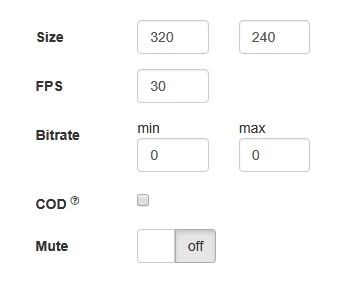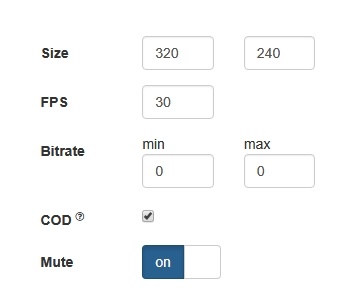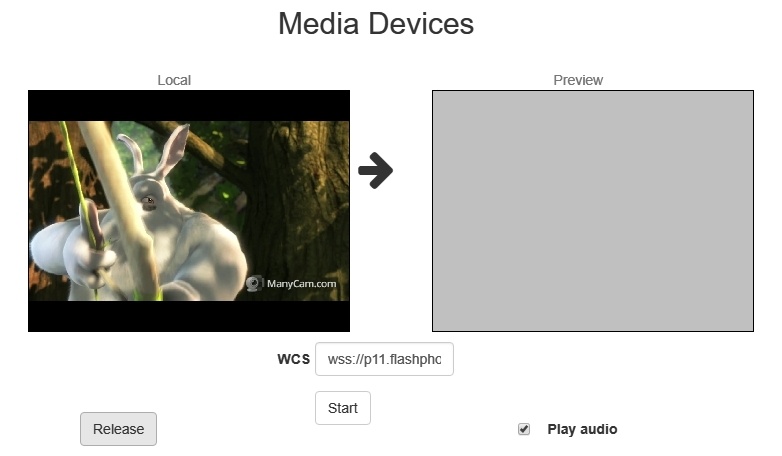WCS allows configuring the camera and the microphone from a browser. Let's see how this can be done and what parameters you can adjust when an audio and video stream is captured. We use the Media Devices web application as an example:
Microphone settings
1. Selecting the microphone from the list
code:
Flashphoner.getMediaDevices(null, true).then(function (list) {
list.audio.forEach(function (device) {
var audio = document.getElementById("audioInput");
var i;
var deviceInList = false;
for (i = 0; i < audio.options.length; i++) {
if (audio.options[i].value == device.id) {
deviceInList = true;
break;
}
}
if (!deviceInList) {
var option = document.createElement("option");
option.text = device.label || device.id;
option.value = device.id;
audio.appendChild(option);
}
});
...
}).catch(function (error) {
$("#notifyFlash").text("Failed to get media devices");
});
2. Adjusting microphone gain (works in Chrome only)
code:
$("#micGainControl").slider({
range: "min",
min: 0,
max: 100,
value: currentGainValue,
step: 10,
animate: true,
slide: function (event, ui) {
currentGainValue = ui.value;
if(previewStream) {
publishStream.setMicrophoneGain(currentGainValue);
}
}
});
3. Enabling error correction (for the Opus codec only)
code:
if (constraints.audio) {
constraints.audio = {
deviceId: $('#audioInput').val()
};
if ($("#fec").is(':checked'))
constraints.audio.fec = $("#fec").is(':checked');
...
}
4. Setting stereo/mono mode.
code:
if (constraints.audio) {
constraints.audio = {
deviceId: $('#audioInput').val()
};
...
if ($("#sendStereoAudio").is(':checked'))
constraints.audio.stereo = $("#sendStereoAudio").is(':checked');
...
}
5. Setting audio bitrate in kbps
code:
if (constraints.audio) {
constraints.audio = {
deviceId: $('#audioInput').val()
};
...
if (parseInt($('#sendAudioBitrate').val()) > 0)
constraints.audio.bitrate = parseInt($('#sendAudioBitrate').val());
}
6. Turning off the microphone (mute).
code:
if ($("#muteAudioToggle").is(":checked")) {
muteAudio();
}
Camera settings
1. Camera selection
code:
Flashphoner.getMediaDevices(null, true).then(function (list) {
...
list.video.forEach(function (device) {
...
});
}).catch(function (error) {
$("#notifyFlash").text("Failed to get media devices");
});
2. Switching cameras.
code:
$("#switchBtn").text("Switch").off('click').click(function () {
publishStream.switchCam();
}).prop('disabled', $('#sendCanvasStream').is(':checked'));
Switching of the camera can be done "on the fly" during stream broadcasting. Here is how switching works:
- On PC cameras switch in the order they are defined in the device manager of the operating system.
- On Android, if Chrome is used, the default is the frontal camera. If Firefox is used, the default is the rear camera.
- On iOS in the Safari browser, by default the frontal camera is selected, but in the drop-down the rear camera is the first.
3. Specifying the resolution of the video
code:
function resizeLocalVideo(event) {
var requested = constraints.video;
if (requested.width != event.target.videoWidth || requested.height != event.target.videoHeight) {
console.warn("Camera does not support requested resolution, actual resolution is " + event.target.videoWidth + "x" + event.target.videoHeight);
}
$("#publishResolution").text(event.target.videoWidth + "x" + event.target.videoHeight);
resizeVideo(event.target);
}
4. Setting FPS
code:
if (constraints.video) {
if (constraints.customStream) {
...
} else {
...
if (parseInt($('#fps').val()) > 0)
constraints.video.frameRate = parseInt($('#fps').val());
}
}
5.Setting video bitrate in kbps
code:
if (constraints.video) {
if (constraints.customStream) {
...
} else {
...
if (parseInt($('#sendVideoMinBitrate').val()) > 0)
constraints.video.minBitrate = parseInt($('#sendVideoMinBitrate').val());
if (parseInt($('#sendVideoMaxBitrate').val()) > 0)
constraints.video.maxBitrate = parseInt($('#sendVideoMaxBitrate').val());
...
}
}
6. Setting CPU Overuse Detection
code:
if (!$("#cpuOveruseDetection").is(':checked')) {
mediaConnectionConstraints = {
"mandatory": {
googCpuOveruseDetection: false
}
}
}
7. Turning off the camera (mute)
code:
if ($("#muteVideoToggle").is(":checked")) {
muteVideo();
}
Testing camera and microhpone capturing locally
Local camera and microphone test is intended to check capturing in browser without publishing stream to server.
код:
function startTest() {
if (Browser.isSafariWebRTC()) {
Flashphoner.playFirstVideo(localVideo, true);
Flashphoner.playFirstVideo(remoteVideo, false);
}
Flashphoner.getMediaAccess(getConstraints(), localVideo).then(function (disp) {
$("#testBtn").text("Release").off('click').click(function () {
$(this).prop('disabled', true);
stopTest();
}).prop('disabled', false);
window.AudioContext = window.AudioContext || window.webkitAudioContext;
if (Flashphoner.getMediaProviders()[0] == "WebRTC" && window.AudioContext) {
for (i = 0; i < localVideo.children.length; i++) {
if (localVideo.children[i] && localVideo.children[i].id.indexOf("-LOCAL_CACHED_VIDEO") != -1) {
var stream = localVideo.children[i].srcObject;
audioContextForTest = new AudioContext();
var microphone = audioContextForTest.createMediaStreamSource(stream);
var javascriptNode = audioContextForTest.createScriptProcessor(1024, 1, 1);
microphone.connect(javascriptNode);
javascriptNode.connect(audioContextForTest.destination);
javascriptNode.onaudioprocess = function (event) {
...
}
}
}
} else if (Flashphoner.getMediaProviders()[0] == "Flash") {
micLevelInterval = setInterval(function () {
$("#micLevel").text(disp.children[0].getMicrophoneLevel());
}, 500);
}
testStarted = true;
}).catch(function (error) {
$("#testBtn").prop('disabled', false);
testStarted = false;
});
drawSquare();
}
Setting up codecs
When publishing the stream, there is a possibility to eliminate from WebRTC SDP codecs that should not be used to publish the given stream, for example:
publishStream = session.createStream({
...
stripCodecs: ["h264", "flv", "mpv"]
}).on(STREAM_STATUS.PUBLISHING, function (publishStream) {
...
});
publishStream.publish();
Such a capability is handy when you need to find some workaround for bugs of a browser or if it conflicts with the given codec. For example, if H.264 does not work in a browser, you can turn it off and switch to VP8 when working via WebRTC.
